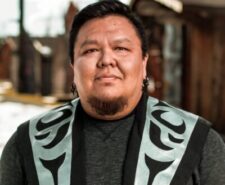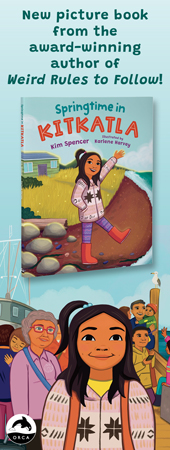Huckleberry pies & salmon stew
A memoir from the 1960s when fishing for a living was a gentler profession.
July 08th, 2025

Writer and marine photographer, Alan Haig-Brown.
“The learning on the boat was a slow, immersive process,” says Alan Haig-Brown, adding “university was an intense rush of lectures and undigested information. Like a slow-cooked roast, the boat learning was rich in flavour and nutrition. The university, with its diverse lectures and specialized faculties, was more like a cafeteria meal served on a segmented plastic plate.”
Review by Graham Chandler
If you’ve ever wondered what a particular job would be like, what’s the best way to find out? Most people would say, why just get down, get your hands dirty and do it, do it. There’s always so much more to be learned “on the job” than just watching or reading about it can reveal. Unless you’re reading someone who got down and did it—for well over a decade, then wrote about what it was like. But there’s a catch with that approach—the inherent problem of becoming a boring read. Which won’t happen if it’s experienced and written by an author with the talents and reputation of Alan Haig-Brown. Then you won’t be able to put it down.
 In Raincoast Chronicles 25: m̓am̓aɫa Goes Fishing (Harbour $24.95), Haig-Brown writes that in 1960 he was living in Campbell River, an 18-year-old newlywed high school dropout and facing meagre employment prospects. But he was more fortunate than many in such circumstances: his wife’s father, Herb Assu, was a talented and successful fisher whose family owned a seine boat. You can probably guess how this story begins now, especially when you read what Haig-Brown says of his immense respect for Herb. “He was…the man who informed so much of my formative years between 1960 and 1973,” he writes. “Herb was both my skipper and my father-in-law. The two roles were inseparable, and the latter explained the former. Just as I became a part of the family, I became part of the crew on the family boat.”
In Raincoast Chronicles 25: m̓am̓aɫa Goes Fishing (Harbour $24.95), Haig-Brown writes that in 1960 he was living in Campbell River, an 18-year-old newlywed high school dropout and facing meagre employment prospects. But he was more fortunate than many in such circumstances: his wife’s father, Herb Assu, was a talented and successful fisher whose family owned a seine boat. You can probably guess how this story begins now, especially when you read what Haig-Brown says of his immense respect for Herb. “He was…the man who informed so much of my formative years between 1960 and 1973,” he writes. “Herb was both my skipper and my father-in-law. The two roles were inseparable, and the latter explained the former. Just as I became a part of the family, I became part of the crew on the family boat.”

Herb Assu, Alan Haig-Brown’s “professor of the waters and of life,” in a boat watching the tides and watching for fish.
And thus begins this brilliant memoir, with a twist: the family to which Haig-Brown refers is part of the We Wai Kai Nation on Quadra Island. And Haig-Brown, with an American mother and British father (the award-winning writer of 28 books Roderick Haig-Brown), was “m’am’ala”—or “white guy”. Cultural understandings, and occasional misunderstandings, provide ample fodder for some entertaining reading.
The volume boasts a plethora of great black & white photographs from the early 1960s and ‘70s, a large number of which were shot by Haig-Brown’s then wife Vicki. These add tremendous value to the book as a source of history of the early Canadian west coast commercial fisheries, as Haig-Brown’s vividly-detailed descriptions of activity and processes contain references to the terminology shown in those well-produced original shots chosen for the book. Just look on pages adjacent to the text and you quickly understand a sequence.
Along the way, Haig-Brown’s writing reflects an early infectious enthusiasm for the life of a west coast fisher—bolstered by an oft-typical sense of adventure felt by an excited teenager on their first full-time job. He learned fast and soon adapted to the unique rhythm and challenges of the fishers’ life. “When you spend months on a small boat with a half-dozen or so other people, you get along or get off. Everyone has their job, and they do it or leave.” But, he writes, not all was work. “In the 1960s, fishing was in some ways a gentler profession.” For example, he talks of taking time to anchor offshore and climb a hill to pick huckleberries, and “Mitzi [Alan’s mother-in-law] would make huckleberry pies” to go along with her delicious salmon stews.

Alan Haig-Brown in the 1960s.
The level of detail he employs when describing a particular process like seining is nothing short of amazing—considering that he’s talking about something he was learning upwards of 60 years ago. Clearly his enthusiasm hasn’t faded; it’s still contagious. Along the way we learn some of the terminology of the industry and new words like “fish peugh,” “brailing,” “hand bombing,” “zine,” “monkey fist” and “bunt.”
Taking in the BC coast from up north for pink salmon, to the south for herring and everything in between, Haig-Brown recounts more than the physical lifestyle. On a week-long December trip to the Port Edward cannery near Prince Rupert, “I learned something about navigating a boat in the dark and snow without radar, but I also learned of the racism that the BC fishery was built on and the deep-seated anger that my fellow crew carried as a result.” He is referring to his admiration of the good-looking salmon seiners built by the Haida people. And he soon learned that, due to debt incurred in their building, these boats were taken away from their owners by “the company.” Sixty years later this is still a cause of pain and anger for the Haida people, he says.
Haig-Brown writes glowingly of his father-in-law Herb—who is featured throughout the book. “He was my professor of the waters and of life,” he writes. “For some of my commercial fishing years, I also attended university. The learning on the boat was a slow, immersive process, while university was an intense rush of lectures and undigested information. Like a slow-cooked roast, the boat learning was rich in flavour and nutrition. The university, with its diverse lectures and specialized faculties, was more like a cafeteria meal served on a segmented plastic plate.” 9781998526185
Vancouver-based writer Graham Chandler has several hundred published stories to his credit and prefers those—like this review—in which much is learned along the way.
*

Alan Haig-Brown (above) visiting Mitzi Assu in Campbell River in the summer of 2018. “She is very special in my life as my first mother-in-law and the cook on the boats that I seined salmon on up to 1973,” Haig-Brown says. “She is also the widow of my skipper, the late Herb Assu and mother of well known skippers Darryl Assu and Mark Assu. Mitzi’s Bay, below the Slide in Johnston Straits is named in honour of her and all the pies that she baked in that tiny galley on the Departure Bay #3. And that is barely touching the surface of this 95-year-old’s productive life.”


This definitely looks like enjoyable reading!